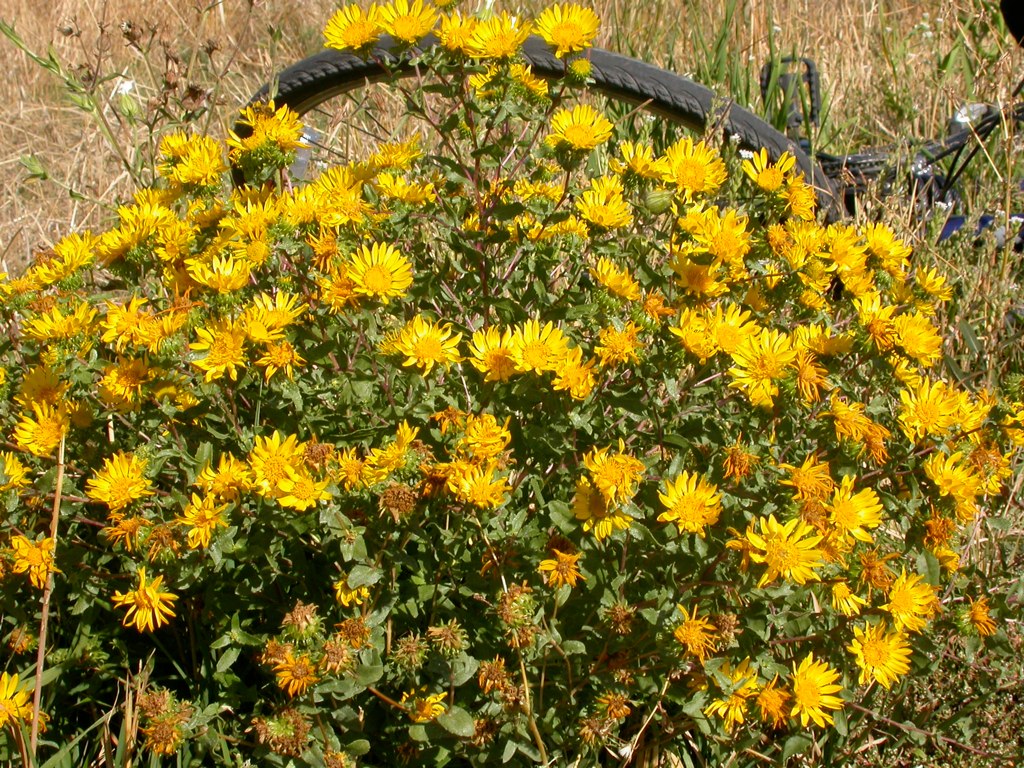Weed Of The Month: Curlycup Gumweed
 | Author:
Allison Kosto, MSU Broadwater County Extension Agent
MSU Broadwater County Extension Agent |
Weed of the Month: Curlycup Gumweed
Allison Kosto
MSU Broadwater County Extension Agent
Often found along roadsides, curlycup gumweed is really easy to see right out because it’s one of few rangeland plants that are still flowering and green. It is a native species, but it can sometimes be unwanted due to its ability to increase under poor rangeland conditions.
Description & Habitat
With the exception of the southeast states, curlycup gumweed is native throughout most of the United States and southern Canada. It tends to prefer dry areas but will also grow in moist soil if nothing else is growing. It can be found in dry prairies, disturbed sites, roadsides, repleted rangelands and abandoned croplands. Curlycup gumweed is used as a medicinal plant, first by the American Indians for a wide range of uses.
Curlycup gumweed is most commonly a biennial (life cycle of two years) and is a warm-season plant, which is why it is more noticeable later in the summer. The first year, it has a low-growing rosette. The second year, it flowers and grows one to three feet tall with several branched stems. The stems are semi-woody, and the plant has a distinct smell. It has numerous yellow flowers that are one-half to one inch in diameter. Under the flowers are structures called bracts that curve downward and are shiny and sticky. It has a deep taproot and reproduces solely by seed.
Curlycup gumweed has the unique ability to accumulate selenium, which could lead to poisoning in livestock. However, it is rarely grazed due to high levels of tannins, volatile oils, bitter alkaloids and glucosides that make it taste unpleasant. Even though it is not considered a major invasive plant, it can expand following a disturbance such as abandoned crop fields, overgrazed areas or replanted rangeland. It is commonly seen along roadsides. It can also be an indication of poor range management. It’s not extremely competitive, so once other species establish it tends to slow down its expansion. However, since livestock do not graze the plant, there are times where control measures may be warranted to reduce curlycup gumweed and allow space for more desirable species.
Management
Avoiding disturbance or overgrazing and maintaining a healthy population of native or desired species is often effective to keep curlycup gumweed at a manageable level. Oftentimes, it is not necessary to remove an entire stand of curlycup gumweed. Simply thinning or reducing is often sufficient.
Physical control methods such as burning, cutting or mowing are often not effective due to the woody stem and taproot. Manually removing the plants by digging can be successful on young plants as long as a majority of the root system is removed.
Herbicides are also an option. It is naturally resistant to glyphosate products such as Roundup. Common chemicals include 2,4-D, Banvel and Chaparral. Research has shown that early treatment in June results in control of more than 95%. However, late summer applications did not yield good results. Always read and follow the entire label when applying herbicides. Common chemical names are used for clarity but does not imply endorsement of a product or brand.
For assistance on weed identification and management, contact the MSU Extension Office in Broadwater County at 406-266-9242 or allison.kosto@montana.edu.
Article Images
Click on Image Thumbnail(s) to view fullsize image
PhotoCredit: Matt Levin, Bozeman MT
Image 1 Caption: Curlycup Gumweed
Photo Credit: Matt Levin, Bozeman MT
